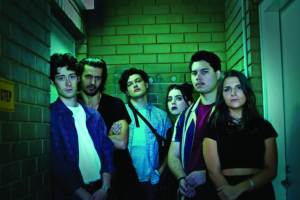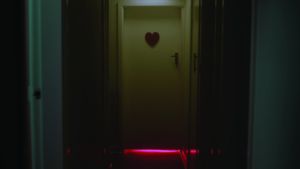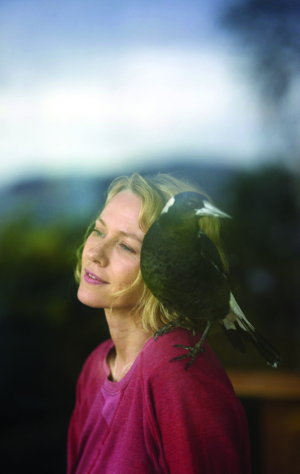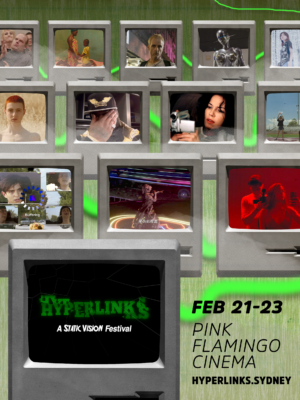Barbara Hammer remembers that she couldn’t find any lesbian film images when she went to film school in the seventies. ‘I wasn’t thinking “I want to make a lesbian film”, but I was coming out at that time, and I wanted to make films about my life changing experiences.’
As a result of making love to a woman, I made Dyketactics (1974), a short lesbian lovemaking film. I was exploring my own personality and began to express my interior feelings through the expressive medium of film. So I was making films about a combination of lesbian issues and personal experience. I also wanted to put lesbians on screen. I felt that my energy and enthusiasm for being a dyke should be reflected in my art.
There was a big gap in lesbians on screen until the seventies, then there was the groundbreaking Go Fish (Rose Troche, 1994).

Richard Watts says, ‘film holds a up mirror to our lives, and most of the time it reflects white middle class straights, without reflecting the diversity in society. It’s good to see ourselves on film, and not only in gay films’.
That theme of invisible communities continues with old age. Barbara is now collecting images of her aging body. ‘I’m the invisible older woman within both lesbian and hetero communities. A white haired male is distinguished, and a white haired woman is ignored in meetings, in shops and on dance floors.’
Lisa Daniel believes that the commercialization of queer cinema has changed how queers are represented on film. ‘It’s better than being depicted as homicidal lesbians. It’s good to move on to something more realistic.’
She mentions By Hook or by Crook (Harry Dodge, 2001), a film which doesn’t pigeonhole the sexuality of the characters. ‘It’s a film that has a queer sensibility with a transgendered theme.’
Helen Hok-Sze Leung, Assistant Professor of Women’s Studies at Simon Fraser University in Canada, also talks about the diversity and alternate representation of queers, but in the context of Asian cinema. In the latest issue of The Bent Lens she writes:
The complex histories of their gender practices and sexual desire have produced films that suggest alternative models of queer identity, politics and aesthetics.
Themes such as homophobia and colonialism, indigenous queer identities, and queer identities that do not neatly correspond to categories of lesbian, gay, bisexual and transgender, are just a few examples of the ways in which Asian films are reconfiguring the parameters of queer cinema.[1]Lisa Daniel & Claire Jackson, The Bent Lens, Allen & Unwin, Australia, 2003, p.14.
According to Richard, representation of gay characters varies in the mainstream.
Queers are now given more realistic sexual experiences. Previously, for example in Melrose Place, there was no gay sex life (depicted). There was a squeamishness in recognizing gay sex. Even gays kissing on screen was a big thing. In Philadelphia (Jonathan Demme, 1993), there was no kissing, or anything happening in bed. But it did show that a deep and romantic relationship could form between two gay characters.
There was also a time where only positive gay images could be shown. In 1995, before Lisa’s time, the Queer Film Festival refused to screen a film about a gay serial killer, as this was a negative image of gays.

This year’s Queer Film Festival had a plethora of diverse queer images and stories. Lisa maintains that,
the Queer Film Festival shows more independent and alternative stuff. [As QFF Director] I can see what’s on the mind of the queer collective consciousness. This year there were lots of submissions on queer parenting and religious issues. Last year it was dating issues. There has been a major shift in the type of films screened at the festival. We’re moving away from bitter and twisted lesbians, coming out issues and how my queer life is hard. We now have films that focus more on great stories, with great narratives, that just happen to have queer characters. They are not labouring the point.
I don’t differentiate between liking queer film and film in general; a good film is a good film, regardless of whether it’s a queer film.
Richard agrees. ‘Queer films have become more about general life experience,’ rather than specific queer experiences.
Walking on Water (Tony Ayres, 2002) is a fantastic film that worked for both gay and straight audiences. The queer characters were strong, and not peripheral. It was a realistic representation of gays. It showed the overlap between gay and straight (lives). This film spoke to both gay and straight people. The sexuality didn’t matter; it was a story well told.
Queer film has now moved much more into the mainstream. In the past, these films would only be seen at the QFF, but they’re now in the Melbourne International Film Festival, and queer characters are popping up in straight TV, like in The Secret Life Of Us (Channel Ten). For queer film-makers it’s great, their films reach wider audiences, and that’s a good thing.
Despite the commercial gains and exposure of queer going mainstream, Barbara has reservations about it all:
The politics of queer film-making has gone now, and that is not a good thing. There are still films to make and issues to fight. We’re becoming less political and more mainstream. We need to continue to make alternative films, and not let the mainstream swallow [us] up.
But underground queer cinema is growing in some countries where queer content in cinema is outlawed. As Helen writes in The Bent Lens: ‘Some examples (include) a film about queer Muslims in the Middle East, the everyday life of a transsexual woman in Iran, and recent dramatic features from Mainland China which cast a provocative look at queer lives in Beijing’.[2]ibid, p. 14.
Fish & Elephant (Jin Nian Xia Tian and Li Yu, 2001) is one of these underground Chinese films and was recently screened at this year’s Queer Film Festival.

Richard points out that ‘the drawback of queer representation in mainstream media is that they only portray one facet – not the diversity – of gay life’.
He wasn’t impressed with The Adventures of Priscilla, Queen of the Desert (Stephan Elliot, 1994). ‘It didn’t do a lot for me. It’s a very mainstream film which showed elements of contemporary gay society which, quite frankly, bore me. I’d like to see queer versions of exploring subcultural life, views which we don’t get a chance to see in mainstream media, for example, older lesbian couples, queer street kids.’
Queer films in Australia are few and far between. We’ve all heard of Ana Kokkinos and Tony Ayres, but, as Lisa says, the Australian industry is not huge.
It’s a cottage industry. A small bunch of queer film-makers know each other and help each other to make films. The current state of film funding is – it’s not financed! The Sum of Us (Geoff Burton, 1994) might have opened a few doors, but Head On (Ana Kokkinos, 1998) was a bit more challenging (as a film).
Richard also maintains that there aren’t enough queer films made in Australia:
Apart from Ana Kokkinos and Tony Ayres, there aren’t many film-makers. I’d like to see more serious drama, more challenging films with depth rather than light comedy or fluffy drama, and more features. Short films like Saturn’s Return (Wenona Byrne, 2000) give me hope.





